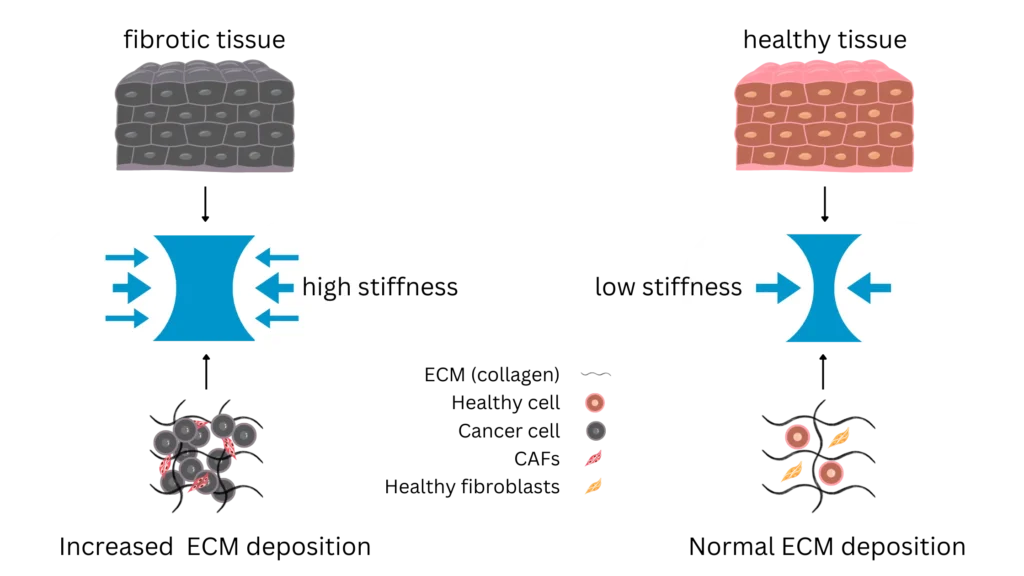When you picture disease research, your mind might jump to scientists in lab coats peering through microscopes or mixing chemicals in test tubes. While that is certainly a big part of it, there is another, less obvious yet equally fascinating side to this work: studying the mechanical properties of tissues. Yes, you heard it right—how stiff a tissue is can reveal a treasure trove of information about its health.
Why mechanical properties matter
Mechanical properties of tissues, like stiffness and viscoelasticity, can tell us much about how healthy or diseased they are. These traits can be examined at various levels, from tiny parts of a cell to large tissue areas, making them excellent indicators—or biomarkers—of diseases. Unlike traditional biomarkers, which often depend on chemical or molecular signals, mechanical biomarkers offer a unique, label-free approach to investigating diseases and potential treatments.
Mechanical properties of ex vivo tissue as a biomarker
- Understanding disease mechanisms – Mechanical biomarkers provide essential evidence about the disease’s pathophysiology. For instance, cancerous tissues are often stiffer than healthy tissues, offering clues about tumor biology and progression. The same applies to liver diseases, where stiffening of the tissues can indicate disease severity.
- Advancing drug discovery – Mechanical biomarkers play a significant role in preclinical studies in the quest for potential treatments. They help measure how tissues respond to advancing therapies, sometimes with higher sensitivity than traditional laboratory tests. For instance, changes in breast tissue stiffness contribute to breast cancer development, so scientists are testing drugs to block excessive matrix production responsible for that.
- Bridging preclinical and clinical studies – The mechanical properties of tissues in experimental models, whether in animals or 3D cultures, can be compared to those in humans. This helps validate these models and ensures preclinical findings translate effectively to clinical applications.
- Ensuring quality control – Mechanical biomarkers provide objective, quantitative data that can enhance the reproducibility and reliability of preclinical studies. They complement traditional analyses, offering a more comprehensive understanding of diseases and the likelihood of success of their potential treatments.

Can the mechanical properties of biomaterials act as biomarkers?
Biomaterials used in medical implants, drug delivery systems, and tissue engineering must possess specific mechanical properties to ensure compatibility, functionality, and longevity. Understanding these properties helps us design effective biomedical devices and materials. However, it is important to note that biomaterial mechanics cannot be considered biomarkers. Biomarkers are indicators of specific physiological conditions of cells or tissues. In contrast, while influential, the mechanical properties of biomaterials do not directly indicate a particular physiological state. Thus, they serve a different but equally significant role in biomedical research and application.
Overcoming challenges
Despite their promise, mechanical biomarkers face several challenges. Variability in measurement techniques and conditions can lead to inconsistent results. Standardizing these methods and developing robust calibration protocols is crucial for widespread adoption in preclinical and clinical settings. However, their non-invasive, label-free, and cost-effective nature makes them ideal for drug screening and disease monitoring, adding it as another tool in the researcher’s toolbox to achieve better outcomes.
The future of mechanical biomarkers
The field of mechanical biomarkers is on the brink of significant advancements. Scientists are developing high-throughput, user-friendly, and reliable techniques that could make these biomarkers an integral part of disease investigation. As these technologies evolve, the secret language of tissue mechanics will become more apparent, paving the way for more precise and effective disease diagnosis and treatment.
So, next time you think about disease research, remember that behind those microscopes and test tubes, there is a fascinating world of tissue mechanical properties that are helping to unlock innovative frontiers in preclinical studies.
Disclaimer: This blog simplifies complex scientific information for general understanding and should not be taken as medical advice. The content is meant for educational purposes, highlighting advances in mechanobiology and disease investigation. Readers are encouraged to consult scientific articles for detailed insights and to recognize the broader context of this research within the scientific community:
Eroles M, Rico F. Advances in mechanical biomarkers. J Mol Recognit. 2023 Aug;36(8):e3022. doi: 10.1002/jmr.3022.
Cell mechanics as a marker for diseases: biomedical applications of AFM. in: AIP Conference Proceedings. AIP Publishing, 2016: 020057. doi:10.1063/1.4960276
Di Carlo D. A mechanical biomarker of cell state in medicine. J Lab Autom. 2012 Feb;17(1):32-42. doi: 10.1177/2211068211431630.
Xu R, Yin P, Wei J, Ding Q. The role of matrix stiffness in breast cancer progression: a review. Front Oncol. 2023 Oct 17;13:1284926. doi: 10.3389/fonc.2023.1284926.



